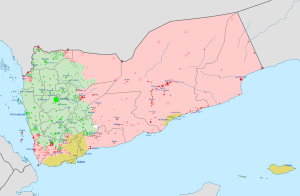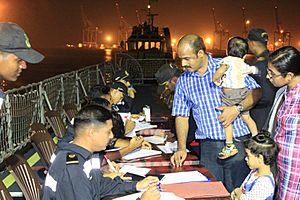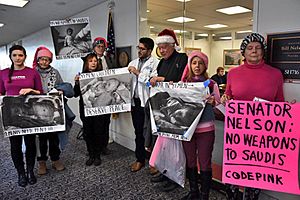Yemeni civil war (2014–present) facts for kids
Quick facts for kids Yemeni civil war |
||||||||||
|---|---|---|---|---|---|---|---|---|---|---|
| Part of the Yemeni Crisis, Arab Winter, War on terror, and the Iran–Saudi Arabia proxy conflict | ||||||||||
 Political and military control in Yemen in October 2022 Republic of Yemen (internationally recognized) and allies Houthi movement Southern Movement and other UAE-backed groups Local, non-aligned forces such as the Hadhramaut Tribal Alliance Al-Qaeda in the Arabian Peninsula (AQAP) Islamic State – Yemen Province (IS-YP) (For a map of the military situation in Yemen and border areas in Saudi Arabia, see the detailed map here.) |
||||||||||
|
||||||||||
| Main belligerents | ||||||||||
|
Alleged support:
|
Tareq Saleh forces (2017–) Support: Non-aligned tribal forces
|
Alleged support:
|
||||||||
| Commanders and leaders | ||||||||||
|
Saudi-led coalition:
|
Casualties:
|
||||||||
| Strength | ||||||||||
1,800 security contractors |
|
|||||||||
| Casualties and losses | ||||||||||
| "Thousands" killed (per Al Jazeera; as of May 2018) 11,000+ killed (Arab Coalition claim; as of December 2017) |
Saudi losses
Emirati losses
2 aircraft lost
3 helicopters lost 1 minesweeper damaged 6 drones lost 1 watercraft damaged
American losses
4 drones shot down
1 helicopter lost 1 tiltrotor craft lost |
|||||||||
| 377,000+ people killed overall (150,000+ from violence) (2014–2021) (UN) 85,000 Yemeni children died from starvation (2015–2018) (Save the Children) ~4,000 dead from cholera epidemic; 2.5+ million cases overall (2016–2021) 4 million people cumulatively displaced (2015–2020) (UNHCR) 500+ killed in Saudi Arabia by Houthi attacks (2014–2016) (Saudi Arabia figure) 3 Emirati civilians killed |
||||||||||
The Yemeni Civil War is a conflict that started in late 2014. It is mainly between two groups: the Presidential Leadership Council, led by Rashad al-Alimi, and the Supreme Political Council, led by Mahdi al-Mashat. Both groups say they are the official government of Yemen.
The war began in September 2014 when Houthi forces took control of the capital city, Sanaa. After this, the Houthis quickly took over the government. In March 2015, the Houthi-led group announced they would try to remove the then-president, Abdrabbuh Mansur Hadi. They wanted to control more areas.
The Houthis, working with military forces loyal to former President Ali Abdullah Saleh, started fighting in southern provinces. By March 25, 2015, the Houthis reached the city of Aden, where Hadi's government was based. President Hadi then left the country.
At the same time, a group of countries led by Saudi Arabia began military actions. They used air strikes to try and bring back the former Yemeni government. Even though Iran supports the Houthis, it did not directly join the fighting. Many see this conflict as part of a bigger rivalry between Iran and Saudi Arabia.
Currently, Houthi forces control Sanaa and most of what was once North Yemen. They have fought against pro-government forces supported by Saudi Arabia. Since 2017, the groups fighting against the Houthis have also started fighting each other. This happened after the Southern Transitional Council was formed.
Groups like Al-Qaeda in the Arabian Peninsula (AQAP) and the Islamic State have also carried out attacks. The United Nations helped arrange a two-month ceasefire in April 2022. This allowed fuel to enter Houthi-controlled areas and some flights from Sanaa Airport. The ceasefire was extended but officially ended in October, though it is still mostly active.
The UN says that over 150,000 people have died in Yemen due to the war. Another 227,000 people are estimated to have died because of a severe famine and lack of healthcare. In 2018, the UN warned that 13 million Yemenis could face starvation. This could become the worst famine in 100 years.
Many international groups have criticized the bombing campaign led by Saudi Arabia. This campaign has included bombing civilian areas. The United States has provided support to the Saudi-led campaign. This support continues even though the US government had promised to stop it.
Contents
How the Conflict Started
Yemen has a long history with two main Islamic groups: Zaydis (a branch of Shia Islam) and Sunnis. For a long time, Zaydis were powerful in the north. Sunnis became more popular later. These two groups often competed.
After the Ottoman Empire's rule ended, Yemen was partly united. During this time, Zaydis had more power over Sunnis. This created differences in how people were treated. In 1962, the Zaydi leader was overthrown. This led to a civil war between those who wanted a republic and those who wanted a king.
Saudi Arabia got involved to support the king. But in 1970, Yemen became a republic. Meanwhile, in the south, a socialist state called the People's Democratic Republic of Yemen (PDRY) was formed. It was allied with the Soviet Union.
The PDRY also got involved in the north's conflicts. Later, Ali Abdullah Saleh became president of the Yemen Arab Republic. He ruled for 33 years. A big event during his rule was the unification of Yemen in 1990. Even though a civil war broke out in 1994, Saleh won. Yemen then became the Republic of Yemen.
Saleh tried to stay in power and even wanted his son to take over. But strong protests forced him out. Around this time, a group called "Friends of Yemen" was formed. It was meant to fight Al-Qaeda in the Arabian Peninsula (AQAP). This group became more involved during the Arab Spring protests.
Understanding the Houthis
The Houthis, also known as Ansar Allah, are a Zaydi group. They come from the mountainous Sa'dah region in northern Yemen, near Saudi Arabia. They started a small rebellion against the Yemeni government in 2004. This happened after their leader, Hussein Badreddin al-Houthi, was killed. He had protested against government policies.
The fighting grew stronger and weaker over the years. Several peace agreements were made but often broken. In 2009, the Houthi rebellion became more intense. Saudi Arabia briefly joined the Yemeni government's side. But a ceasefire was signed the next year.
During the early Yemeni Revolution in 2011, Houthi leader Abdul-Malik al-Houthi supported protests against President Ali Abdullah Saleh. Later that year, the Houthis surrounded a village called Dammaj. This was a step towards gaining more control in Sa'dah.
The Houthis did not take part in the 2012 election. They also did not fully support a peace agreement in 2014. This agreement would have extended President Hadi's time in office. By mid-2014, fighting between the Houthis and other groups spread to other areas, including Sanaa.
Impact on People
The war has caused a terrible humanitarian crisis in Yemen. Many people do not have enough water, food, or electricity. In April 2015, over 10 million Yemenis were affected. Many people had to leave their homes.
Organizations like UNICEF and Oxfam have tried to help. They have sent medicine and supplies. The United Nations also asked for aid, and Saudi Arabia promised to provide money. However, aid groups warned that short ceasefires were not enough to fix the huge problems.
Things got much worse when a strong storm, Cyclone Chapala, hit Yemen in November 2015. The war has also damaged healthcare facilities. This means many children die from preventable diseases.
In 2017, a cholera epidemic broke out again. Cholera is a serious disease that spreads through dirty water. It was reported that one person was dying every hour from cholera in mid-June. By June 2017, there were over 200,000 cases and 1,300 deaths.
The International Committee of the Red Cross (ICRC) had to reduce its staff in Yemen in 2018. This was because their workers were being targeted. Since the war began, over 10,000 people have been killed and 40,000 wounded. Most of these injuries are from air raids.
Travel for medical treatment is very difficult because airports are closed or have limited flights. Many people cannot afford the high cost of tickets.
A UN report in 2019 warned that Yemen could become the poorest country in the world if the war continues. By 2022, 79% of people could live below the poverty line.
In 2019, Amnesty International reported that millions of people with disabilities are not getting medical help because of the war. The UN has called this the worst humanitarian crisis.
In 2020, aid to Houthi-controlled areas was reduced. Donors were unsure if the aid was reaching the people who needed it most. By June 2020, over 3.6 million people had been forced to leave their homes.
Children and Women
The war has had a terrible impact on children. By December 2020, over 3,000 children had died directly from the war. Many more have died from lack of food, healthcare, and basic services. The UN estimates that by the end of 2021, 70% of all war deaths (about 259,000) were children under five.
Children as young as 10 are being recruited into armed groups. This is happening even though there is a law against it. Between March and April 2015, at least 140 children were recruited. In 2018, 1.8 million children in Yemen were severely malnourished.
UNICEF reports that two million children have stopped going to school since the war began in 2015. Another 3.7 million children's education is uncertain because teachers have not been paid.
In October 2019, Save the Children warned about a big increase in cholera cases in northern Yemen. This crisis, made worse by fuel shortages, has affected thousands of children and their families.
Health Challenges
The UN estimates that by December 2020, the war had caused about 230,000 deaths. About 130,000 of these deaths were from indirect causes. These include not enough food, healthcare, and basic services. Earlier, in 2018, Save the Children estimated that 85,000 children had died from starvation in the previous three years.
Between 2016 and 2019, over 2 million suspected cholera cases were reported. There were also 3,716 deaths from cholera. The seasonal flu virus has also killed many people. Poor medical facilities and widespread poverty mean many sick people die at home.
The war has also made it hard to track diseases. The system for early warning about diseases is broken. This is because the government does not control the system in Houthi areas, and vice versa.
By the end of 2021, the UN estimated that the conflict had caused over 377,000 deaths. Again, 70% of these deaths were children under five.
Living Conditions
The civil war has greatly affected the quality of life for Yemenis. People have faced huge difficulties. Even though mines are banned, Houthi forces have placed anti-personnel mines in many areas. Thousands of civilians are injured by these mines, often losing legs or eyes. It is thought that over 500,000 mines have been laid.
A group of nine countries led by Saudi Arabia has launched many airstrikes. Between March 2015 and December 2018, over 4,600 civilians were killed. Much of the infrastructure for producing, storing, and distributing goods and food has been destroyed. Factories have stopped working, and many people have lost their jobs.
Because less is being produced, food, medicines, and other basic items are hard to find. Their prices have gone up, and many civilians cannot afford them.
Refugees and Evacuations
Many people have fled Yemen since the war began. They have gone to nearby countries like Djibouti, Somalia, and Oman. By August 2015, almost 100,000 people had fled Yemen. By September 2016, 2.4 million Yemenis were displaced within their own country. Another 120,000 sought safety in other countries.
In 2018, about 500 refugees from Yemen came to Jeju Island in South Korea. This caused some concern among the local people. Despite the dangers, nearly 150,000 migrants from Ethiopia arrived in Yemen in 2018. Most were trying to reach Saudi Arabia for work.
In October 2019, Kuwait donated $12 million to the UNHCR. This money was to help people who had been forced to leave their homes in Yemen.

Many countries have helped their citizens leave Yemen.
- The Royal Saudi Navy helped diplomats and UN staff leave Aden in March 2015.
- Pakistan sent flights to evacuate about 500 of its citizens.
- India used ships and planes to evacuate over 4,640 Indians and 960 people from 41 other countries.
- China sent a warship to evacuate its citizens and other foreigners.
- The Philippines evacuated 240 Filipinos.
- Malaysia used planes to evacuate about 600 people, including citizens from other Southeast Asian countries.
- Indonesia also sent planes to evacuate its citizens.
- Ethiopia planned to airlift its citizens out of Yemen.
- Russia evacuated over 1,000 people of different nationalities.
Efforts for Peace
The Yemeni Civil War has been a very difficult conflict. It has caused a huge humanitarian crisis. But in recent years, there have been efforts to find a peaceful solution.
One important step was the Stockholm Agreement in December 2018. This agreement was made between the Yemeni government and the Houthi rebels. It focused on a ceasefire in the city of Hodeida. It also aimed to move forces and help with humanitarian needs. This agreement was seen as a big step to reduce suffering and allow for more talks.
Since then, the United Nations has helped with many rounds of talks. These discussions have covered finding a full political solution, exchanging prisoners, and setting up a new government. The main goal is to solve the reasons for the conflict and bring peace back to Yemen.
Another important agreement was the Riyadh Agreement in November 2019. This was between the Yemeni government and the Southern Transitional Council (STC). It aimed to solve power struggles in southern Yemen by sharing power between the two groups. This was seen as a step towards a united Yemen.
Even with this progress, reaching peace in Yemen is still hard. There are ongoing clashes, political disagreements, and rivalries between countries in the region. Also, the humanitarian situation is still very bad, with millions of people needing urgent help.
Environmental Challenges
Yemen is facing a severe crisis with water, sanitation, and hygiene. The lack of proper government has left Yemen without a good water supply. Poor sanitation and dirty water have made people's health much worse. This is clear from the increasing number of cholera cases since 2015.
The whole country has a water shortage. The price of drinking water has more than doubled. Most Yemenis cannot afford clean drinking water. The problem is widespread, making it hard to get water to everyone regularly.
Fuel shortages have made the water crisis even worse. Water pumping stations are running out of fuel. Over 3 million people rely on these pumps. The ICRC has been working to prevent the water crisis from getting worse. They buy diesel to provide clean water. Water levels in wells are dropping, and saltwater is getting into the freshwater supply.
Water has also been used as a weapon in the war. Unlike other countries in the Middle East, Yemen does not have rivers for water. In 2017, only a small part of the city of Taiz had public water supply. Because of the conflict, aid groups have struggled to reach sanitation facilities due to safety concerns.
The war has also hurt farming. There is a severe lack of food and plants. Agricultural production has suffered greatly, leading to the threat of famine. Since April 2015, Yemen has been under a blockade by land, sea, and air. This has stopped many foreign resources from reaching Houthi-controlled areas.
Yemen imports 90% of its food. So, this blockade has had serious effects on food availability. It is reported that 13 million people go hungry every day, and 6 million are at risk of starvation. Some reports suggest that the Saudi-led coalition has deliberately destroyed farms in Houthi areas. This makes the food shortage worse and forces the Houthis to rely on imports, which are hard to get.
Images for kids
See also
 In Spanish: Guerra civil yemení (2014-presente) para niños
In Spanish: Guerra civil yemení (2014-presente) para niños



